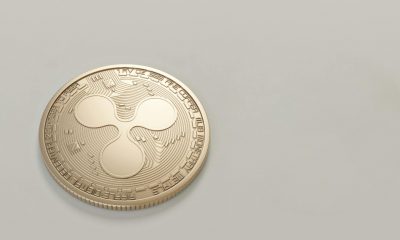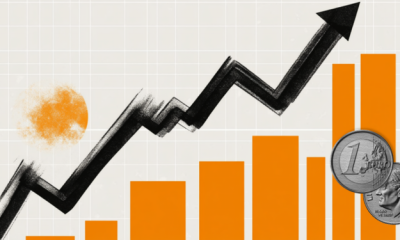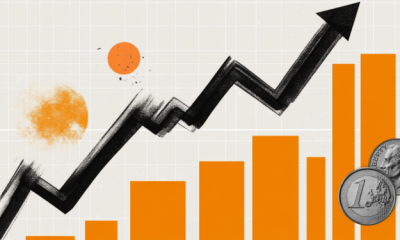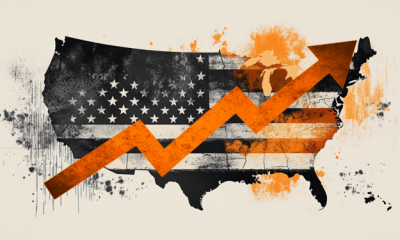

others
Gold prices climbed on falling US yields and soft US Dollar – Crypto News
- Gold bounces to $2,347 from daily lows of $2,322, up 0.41%.
- Slower US GDP growth and rising unemployment claims weaken the Greenback.
- Traders eye April’s PCE inflation data, which could dictate XAU/USD’s direction.
Gold prices trimmed some of Wednesday’s losses and rose 0.41% on Thursday after the US Gross Domestic Product (GDP) showed the economy is slowing, reigniting hopes that the US Federal Reserve (Fed) may cut rates later in the year.
The XAU/USD trades at $2,347, bouncing off daily lows of $2,322. The yield of the US 10-year note collapsed almost seven basis points (bps) to 4.548%, while the Greenback followed suit. The US Dollar Index (DXY) lost 0.43%, at 104.67.
The US economy grew at a slower rate than in the fourth quarter of last year, indicating that higher borrowing costs set by the Fed are taking their toll on the economy. Meanwhile, the US Department of Labor revealed an increase in the number of people applying for unemployment benefits.
Recently, New York Fed President John Williams grabbed the headlines. He said that monetary policy is well-positioned, that inflation is too high, and that he doesn’t feel urgency to slash interest rates. He added that inflation would reach the Fed’s 2% goal in early 2026.
Even though he was hawkish, Gold prices barely heeded his words, standing at current spot prices. The US housing market is also weakening, according to the Pending Home Sales data revealed by the National Association of Realtors.
Ahead in the week, traders are anticipating the release of April’s Personal Consumption Expenditures (PCE) Price Index, which is the Fed’s preferred measure of inflation. The core PCE figure is expected to be 2.8% YoY, while the headline PCE is projected to increase by 0.3% MoM.
Daily digest market movers: Gold price rises as US Treasury yields retreat from multi-week high
- Gold prices advance after bouncing off 50-day Simple Moving Average (SMA) at $2,324.
- US economic docket includes second estimate of Gross Domestic Product (GDP) for Q1 2024, which showed a decline from 3.4% to 1.3% quarter-over-quarter and aligned with analyst expectations.
- Initial Jobless Claims for the week ending May 25 increased to 219K, slightly above the consensus estimate of 218K and higher than the previous week’s reading of 216K.
- Pending Home Sales for April tumbled from 3.6% to -7.7% MoM and, on an annual basis, plunged -7.4% from a 0.1% expansion.
- Fed funds rate futures estimate just 27 basis points of interest rate cuts in 2024, according to data provided by the Chicago Board of Trade (CBOT).
Technical analysis: Gold price climbs, yet remains below $2,350
Gold’s rally is set to continue, yet buyers are struggling to crack the psychological $2,350 mark, which could pave the way for further gains. Short-term momentum favors sellers as the Relative Strength Index (RSI) remains bearish after punching below the 50 midline on Wednesday.
Further gains could be anticipated if XAU/USD buyers reclaim the psychological mark of $2,350. The next target would be the $2,400 level, followed by the year-to-date high of $2,450 and, subsequently, the $2,500 mark.
Conversely, if XAU/USD falls below the 50-day Simple Moving Average (SMA) at $2,321, that could pave the way to challenge the May 8 low of $2,303, followed by the May 3 cycle low of $2,277.
Inflation FAQs
Inflation measures the rise in the price of a representative basket of goods and services. Headline inflation is usually expressed as a percentage change on a month-on-month (MoM) and year-on-year (YoY) basis. Core inflation excludes more volatile elements such as food and fuel which can fluctuate because of geopolitical and seasonal factors. Core inflation is the figure economists focus on and is the level targeted by central banks, which are mandated to keep inflation at a manageable level, usually around 2%.
The Consumer Price Index (CPI) measures the change in prices of a basket of goods and services over a period of time. It is usually expressed as a percentage change on a month-on-month (MoM) and year-on-year (YoY) basis. Core CPI is the figure targeted by central banks as it excludes volatile food and fuel inputs. When Core CPI rises above 2% it usually results in higher interest rates and vice versa when it falls below 2%. Since higher interest rates are positive for a currency, higher inflation usually results in a stronger currency. The opposite is true when inflation falls.
Although it may seem counter-intuitive, high inflation in a country pushes up the value of its currency and vice versa for lower inflation. This is because the central bank will normally raise interest rates to combat the higher inflation, which attract more global capital inflows from investors looking for a lucrative place to park their money.
Formerly, Gold was the asset investors turned to in times of high inflation because it preserved its value, and whilst investors will often still buy Gold for its safe-haven properties in times of extreme market turmoil, this is not the case most of the time. This is because when inflation is high, central banks will put up interest rates to combat it. Higher interest rates are negative for Gold because they increase the opportunity-cost of holding Gold vis-a-vis an interest-bearing asset or placing the money in a cash deposit account. On the flipside, lower inflation tends to be positive for Gold as it brings interest rates down, making the bright metal a more viable investment alternative.
-

 Technology4 days ago
Technology4 days agoChatGPT users are mass cancelling OpenAI subscriptions after GPT-5 launch: Here’s why – Crypto News
-
Technology1 week ago
Binance to List Fireverse (FIR)- What You Need to Know Before August 6 – Crypto News
-

 Technology1 week ago
Technology1 week agoBest computer set under ₹20000 for daily work and study needs: Top 6 affordable picks students and beginners – Crypto News
-
Technology1 week ago
Beyond Billboards: Why Crypto’s Future Depends on Smarter Sports Sponsorships – Crypto News
-
Cryptocurrency1 week ago
Cardano’s NIGHT Airdrop to Hit 2.2M XRP Wallets — Find Out How Much You Can Get – Crypto News
-

 others1 week ago
others1 week agoBank of America CEO Denies Alleged Debanking Trend, Says Regulators Need To Provide More Clarity To Avoid ‘Second-Guessing’ – Crypto News
-

 Cryptocurrency1 week ago
Cryptocurrency1 week agoEthereum Hits Major 2025 Year Peak Despite Price Dropping to $3,500 – Crypto News
-

 Technology1 week ago
Technology1 week agoGoogle DeepMind CEO Demis Hassabis explains why AI could replace doctors but not nurses – Crypto News
-
Business1 week ago
Analyst Spots Death Cross on XRP Price as Exchange Inflows Surge – Is A Crash Ahead ? – Crypto News
-

 De-fi1 week ago
De-fi1 week agoTON Sinks 7.6% Despite Verb’s $558M Bid to Build First Public Toncoin Treasury Firm – Crypto News
-

 De-fi1 week ago
De-fi1 week agoCircle Extends Native USDC to Sei and Hyperliquid in Cross-Chain Push – Crypto News
-

 Blockchain1 week ago
Blockchain1 week agoXRP Must Hold $2.65 Support Or Risk Major Breakdown – Analyst – Crypto News
-

 Blockchain1 week ago
Blockchain1 week agoXRP Must Hold $2.65 Support Or Risk Major Breakdown – Analyst – Crypto News
-
Business1 week ago
Is Quantum Computing A Threat for Bitcoin- Elon Musk Asks Grok – Crypto News
-

 Technology1 week ago
Technology1 week agoElon Musk reveals why AI won’t replace consultants anytime soon—and it’s not what you think – Crypto News
-
others1 week ago
Japan CFTC JPY NC Net Positions down to ¥89.2K from previous ¥106.6K – Crypto News
-

 Cryptocurrency1 week ago
Cryptocurrency1 week agoHow to Trade Meme Coins in 2025 – Crypto News
-

 others1 week ago
others1 week agoIs Friday’s sell-off the beginning of a downtrend? – Crypto News
-
others1 week ago
Pi Network Invests In OpenMiind’s $20M Vision for Humanoid Robots- Is It A Right Move? – Crypto News
-
Business1 week ago
Pi Network Invests In OpenMiind’s $20M Vision for Humanoid Robots- Is It A Right Move? – Crypto News
-

 Technology1 week ago
Technology1 week agoOppo K13 Turbo, K13 Turbo Pro to launch in India on 11 August: Expected price, specs and more – Crypto News
-
Blockchain1 week ago
Shiba Inu Team Member Reveals ‘Primary Challenge’ And ‘Top Priority’ Amid Market Uncertainty – Crypto News
-

 Technology1 week ago
Technology1 week agoOpenAI releases new reasoning-focused open-weight AI models optimised for laptops – Crypto News
-

 Blockchain7 days ago
Blockchain7 days agoCrypto Market Might Be Undervalued Amid SEC’s New Stance – Crypto News
-

 Metaverse7 days ago
Metaverse7 days agoChatGPT won’t help you break up anymore as OpenAI tweaks rules – Crypto News
-

 De-fi6 days ago
De-fi6 days agoCoinbase Pushes for ZK-enabled AML Overhaul Just Months After Data Breach – Crypto News
-
Cryptocurrency4 days ago
DWP Management Secures $200M in XRP Post SEC-Win – Crypto News
-
others1 week ago
SharpLink Buys the Dip, Acquires $100M in ETH for Ethereum Treasury – Crypto News
-

 others1 week ago
others1 week agoVisa and Mastercard’s Payment Dominance Not Threatened by Stablecoins, According to Execs – Crypto News
-
Business1 week ago
Breaking: U.S. CFTC Kicks off Crypto Sprint, Explores Spot and Futures Trading Together – Crypto News
-

 Cryptocurrency1 week ago
Cryptocurrency1 week agoLido Slashes 15% of Staff, Cites Operational Cost Concerns – Crypto News
-
others1 week ago
MetaPlanet Launches Online Clothing Store As Part of ‘Brand Strategy’ – Crypto News
-

 Technology7 days ago
Technology7 days agoiPhone users alert! Truecaller to discontinue call recording feature for iOS from September 30. Here’s what you can do… – Crypto News
-

 Technology7 days ago
Technology7 days agoiPhone users alert! Truecaller to discontinue call recording feature for iOS from September 30. Here’s what you can do… – Crypto News
-

 others6 days ago
others6 days agoUS President Trump issues executive order imposing additional 25% tariff on India – Crypto News
-
Business6 days ago
Analyst Predicts $4K Ethereum Rally as SEC Clarifies Liquid Staking Rules – Crypto News
-

 De-fi6 days ago
De-fi6 days agoSEC Says Some Stablecoins Can Be Treated as Cash, but Experts Warn of Innovation Risk – Crypto News
-
Business6 days ago
XRP Price Prediction As $214B SBI Holdings Files for XRP ETF- Analyst Sees Rally to $4 Ahead – Crypto News
-

 others5 days ago
others5 days agoEUR firmer but off overnight highs – Scotiabank – Crypto News
-

 Blockchain5 days ago
Blockchain5 days agoTrump to Sign an EO Over Ideological Debanking: Report – Crypto News
-

 De-fi5 days ago
De-fi5 days agoRipple Expands Its Stablecoin Payments Infra with $200M Rail Acquisition – Crypto News
-

 others5 days ago
others5 days agoRipple To Gobble Up Payments Platform Rail for $200,000,000 To Support Transactions via XRP and RLUSD Stablecoin – Crypto News
-

 Cryptocurrency4 days ago
Cryptocurrency4 days agoHarvard Reveals $116 Million Investment in BlackRock Bitcoin ETF – Crypto News
-

 Technology4 days ago
Technology4 days agoHumanoid Robots Still Lack AI Technology, Unitree CEO Says – Crypto News
-

 Technology1 week ago
Technology1 week agoAmazon Great Freedom Festival Sale 2025 vs Flipkart Freedom Sale: Comparing MacBook deals – Crypto News
-
Business1 week ago
India’s Jetking Targets 21,000 Bitcoin By 2032 As CFO Foresees $1M+ Price – Crypto News
-

 De-fi1 week ago
De-fi1 week agoCrypto Markets Stall as Trump’s Crypto Policy Report Fails to Spark Momentum – Crypto News
-

 Blockchain1 week ago
Blockchain1 week agoSharpLink Buys $54M in ETH, Holdings Reach $1.65B – Crypto News
-
Business1 week ago
Major U.S. Banks Now pushing “Chokepoint 3.0” to Kill Crypto: a16z Partner – Crypto News
-
others1 week ago
United States CFTC Oil NC Net Positions climbed from previous 153.3K to 156K – Crypto News










